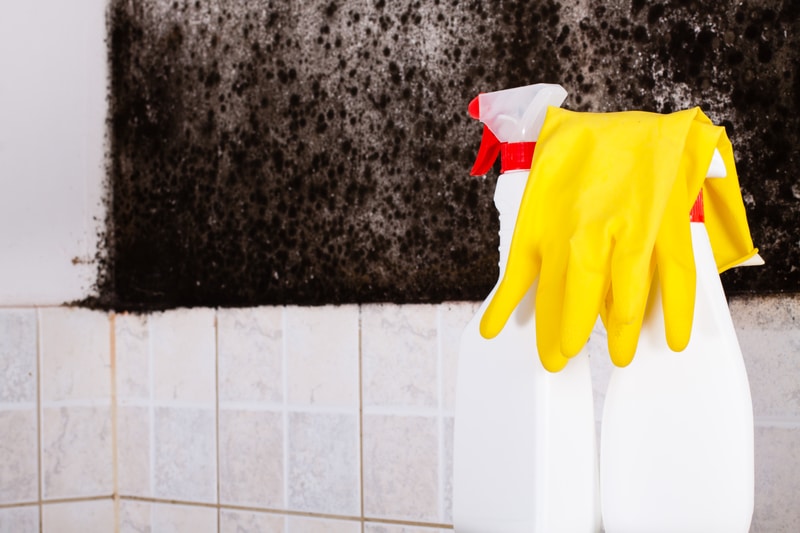
Mould is one of the most common issues in homes across the world. Not only can it plague walls, floors, and ceilings in your home, but it can also attach to your clothing and other uncommon places as well.
To safely remove mould, you’ll need some good old fashioned elbow grease and the right products. There is no “magic remedy” to getting rid of mould, but there are natural ways to remove it.
You should never leave mould where it is, neglecting to remove mould from your home when you first see it could result in the mould problem getting bigger as spores continue to grow. These spores can release harmful vapours into the air you breathe, and may cause your family to experience allergic reactions and even flu-like symptoms.
If you have a significant mould problem in your home which you think may be impacting your health you should contact PureProtect immediately and we can provide a quote to professionally remove mould.
However, if you have a smaller mould issue in your bathroom or other room, these tips will help you safely remove mould and keep your home or business safe.
It’s essential to use products that will work to remove mould completely — not just get rid of surface mould.
If you plan on heading to the store to pick up some mould killer like Exit Mould, you may want to think again. The ingredients in store-bought remedies are often ineffective at removing mould.
However, it’s also important to consider what kind of surface the mould is growing on. Depending on where it’s growing, something as strong as bleach might not do the trick.
You’ll want to refrain from using bleach as a cleaning agent on porous surfaces especially. Bleach can be corrosive, which means it’ll break down porous surfaces even more. This creates more pockets for mould to develop, and soon, you’ll do more harm than good.
Bleach is also known to get rid of the appearance of mould. It takes the colour from the spores, causing it to become almost invisible. This may lead you to believe that your mould problems are over – but think again. If you use bleach to remove mould on porous surfaces, it likely only removed what was on the surface. There is still likely to be mould lingering below the surface, and it’s enough to cause less-than-desirable effects for you and your family.
Although mould can be difficult to remove from surfaces, there are a few products that work to remove mould for good.
If you’re dealing with small areas of mould in your home, try these effective options!
As much as you don’t want to say goodbye to your favourite wicker basket, or your t-shirt that ended up mouldy from condensation, sometimes it’s best to get rid of items that have mould on them. This holds true especially for extra porous materials like wicker or clothing.
A combination of 80% vinegar to 20% water is known to get rid of mould when you use it correctly. You’ll want to ensure that you have two separate buckets of water to avoid cross-contamination when cleaning the mould. You should first dip a microfibre cloth in the mixture, clean the mould, and then rinse it once in each bucket of clean water, ensuring that you don’t cross contaminate.
If you’re looking for something a little more potent than a vinegar and water dilution, try mixing vinegar with baking soda. After doing so, rub the mixture on the heavy mould buildup and let it sit for a few minutes. When you wipe the surface with a clean cloth, the mould should be gone!
Known as one of the most effective ways to remove mould from any surface, tea tree oil helps mould lift from any surface in the matter of a few hours. Try dropping the oil into a spray bottle, spraying on the affected surface, and allowing to sit for 2 hours. When you come back to the mouldy surface, wipe it clean with a wet cloth. Mould be gone!
After you’ve cleaned the affected areas, try these tips to keep mould at bay.
One of the main reasons mould grows is because there is too much moisture in the air that stays on surfaces. If you ventilate the area, the extra condensation won’t build up, and mould may not form in the first place.
If you spill water on something like your carpet or furniture, be sure to dry it up to the best of your ability. Allowing the water to sit can cause mould to form beneath the surface. Likely, you’ll have to tear up the carpet or get rid of the furniture when this happens.
You may not like doing the laundry, but leaving wet clothes in the washer can spell trouble. The moist environment is the perfect place to mould spores to grow, so you’ll want to ensure that your wet clothes make it to the dryer as soon as possible. Even though you might not see mould on your clothes, you’ll be able to smell it.
Mould is nothing to mess with. Not only can it ruin your personal belongings, but if it’s not removed, it can affect the health of you and your family.
By following our tips, you’ll remove mould in areas such as bathrooms walls and floors, however, if you have a significant mould issue, please call PureProtect on 1800 664 602. If you have health issues please contact your doctor immediately and PureProtect can undertake evaluation for the extent of the mould problem in your home or business and provide professional advice on remediation.
PureProtect Pty Ltd © 2020. All rights reserved